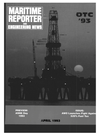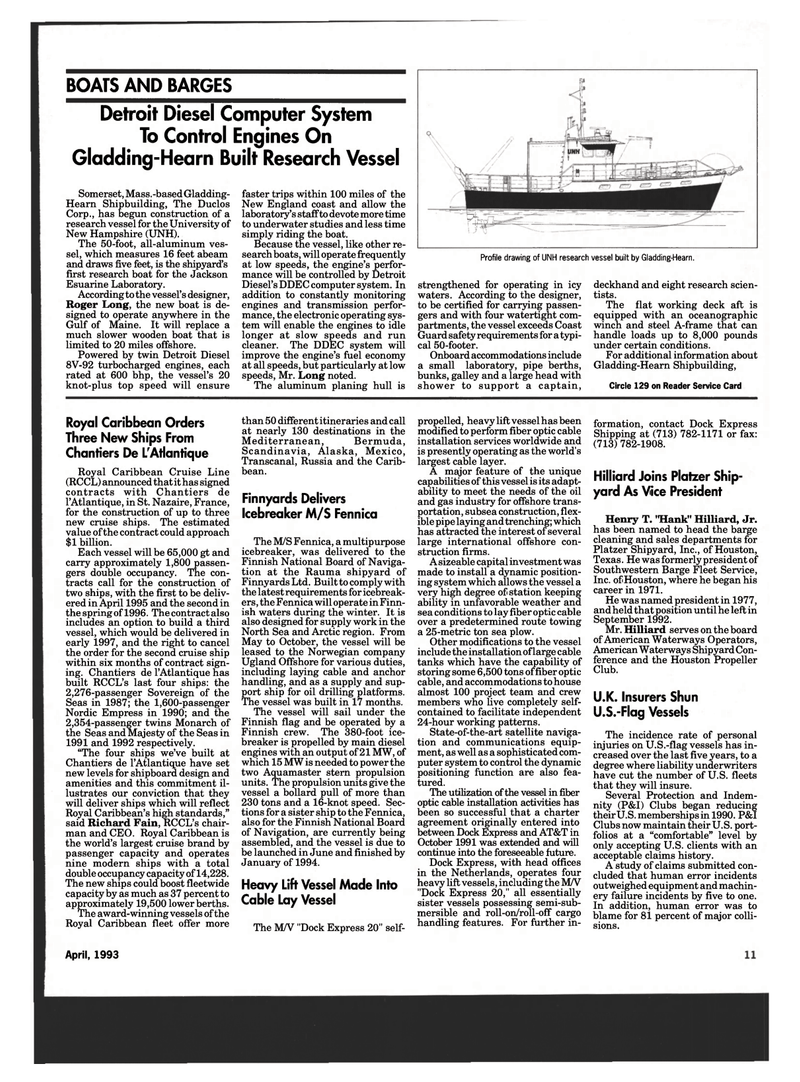
Page 9: of Maritime Reporter Magazine (April 1993)
Read this page in Pdf, Flash or Html5 edition of April 1993 Maritime Reporter Magazine
BOATS AND BARGES
Detroit Diesel Computer System
To Control Engines On
Gladding-Hearn Built Research Vessel
Profile drawing of UNH research vessel built by Gladding-Hearn.
Somerset, Mass.-based Gladding-
Hearn Shipbuilding, The Duclos
Corp., has begun construction of a research vessel for the University of
New Hampshire (UNH).
The 50-foot, all-aluminum ves- sel, which measures 16 feet abeam and draws five feet, is the shipyard's first research boat for the Jackson
Esuarine Laboratory.
According to the vessel's designer,
Roger Long, the new boat is de- signed to operate anywhere in the
Gulf of Maine. It will replace a much slower wooden boat that is limited to 20 miles offshore.
Powered by twin Detroit Diesel 8V-92 turbocharged engines, each rated at 600 bhp, the vessel's 20 knot-plus top speed will ensure faster trips within 100 miles of the
New England coast and allow the laboratory's staff to devote more time to underwater studies and less time simply riding the boat.
Because the vessel, like other re- search boats, will operate frequently at low speeds, the engine's perfor- mance will be controlled by Detroit
Diesel's DDEC computer system. In addition to constantly monitoring engines and transmission perfor- mance, the electronic operating sys- tem will enable the engines to idle longer at slow speeds and run cleaner. The DDEC system will improve the engine's fuel economy at all speeds, but particularly at low speeds, Mr. Long noted.
The aluminum planing hull is strengthened for operating in icy waters. According to the designer, to be certified for carrying passen- gers and with four watertight com- partments, the vessel exceeds Coast
Guard safety requirements for a typi- cal 50-footer.
Onboard accommodations include a small laboratory, pipe berths, bunks, galley and a large head with shower to support a captain, deckhand and eight research scien- tists.
The flat working deck aft is equipped with an oceanographic winch and steel A-frame that can handle loads up to 8,000 pounds under certain conditions.
For additional information about
Gladding-Hearn Shipbuilding,
Circle 129 on Reader Service Card
Royal Caribbean Orders
Three New Ships From
Chantiers De L'Atlantique
Royal Caribbean Cruise Line (RCCL) announced that it has signed contracts with Chantiers de l'Atlantique, in St. Nazaire, France, for the construction of up to three new cruise ships. The estimated value of the contract could approach $1 billion.
Each vessel will be 65,000 gt and carry approximately 1,800 passen- gers double occupancy. The con- tracts call for the construction of two ships, with the first to be deliv- ered in April 1995 and the second in the spring of 1996. The contract also includes an option to build a third vessel, which would be delivered in early 1997, and the right to cancel the order for the second cruise ship within six months of contract sign- ing. Chantiers de l'Atlantique has built RCCL's last four ships: the 2,276-passenger Sovereign of the
Seas in 1987; the 1,600-passenger
Nordic Empress in 1990; and the 2,354-passenger twins Monarch of the Seas and Majesty of the Seas in 1991 and 1992 respectively. "The four ships we've built at
Chantiers de l'Atlantique have set new levels for shipboard design and amenities and this commitment il- lustrates our conviction that they will deliver ships which will reflect
Royal Caribbean's high standards," said Richard Fain, RCCL's chair- man and CEO. Royal Caribbean is the world's largest cruise brand by passenger capacity and operates nine modern ships with a total double occupancy capacity of14,228.
The new ships could boost fleetwide capacity by as much as 37 percent to approximately 19,500 lower berths.
The award-winning vessels of the
Royal Caribbean fleet offer more than 50 different itineraries and call at nearly 130 destinations in the
Mediterranean, Bermuda,
Scandinavia, Alaska, Mexico,
Transcanal, Russia and the Carib- bean.
Finnyards Delivers
Icebreaker M/S Fennica
The M/S Fennica, a multipurpose icebreaker, was delivered to the
Finnish National Board of Naviga- tion at the Rauma shipyard of
Finnyards Ltd. Built to comply with the latest requirements for icebreak- ers, the Fennica will operate in Finn- ish waters during the winter. It is also designed for supply work in the
North Sea and Arctic region. From
May to October, the vessel will be leased to the Norwegian company
Ugland Offshore for various duties, including laying cable and anchor handling, and as a supply and sup- port ship for oil drilling platforms.
The vessel was built in 17 months.
The vessel will sail under the
Finnish flag and be operated by a
Finnish crew. The 380-foot ice- breaker is propelled by main diesel engines with an output of 21MW, of which 15 MW is needed to power the two Aquamaster stern propulsion units. The propulsion units give the vessel a bollard pull of more than 230 tons and a 16-knot speed. Sec- tions for a sister ship to the Fennica, also for the Finnish National Board of Navigation, are currently being assembled, and the vessel is due to be launched in June and finished by
January of 1994.
Heavy Lift Vessel Made Into
Cable Lay Vessel
The M/V "Dock Express 20" self- propelled, heavy lift vessel has been modified to perform fiber optic cable installation services worldwide and is presently operating as the world's largest cable layer.
A major feature of the unique capabilities of this vessel is its adapt- ability to meet the needs of the oil and gas industry for offshore trans- portation, subsea construction, flex- ible pipe laying and trenching; which has attracted the interest of several large international offshore con- struction firms.
A sizeable capital investment was made to install a dynamic position- ing system which allows the vessel a very high degree of station keeping ability in unfavorable weather and sea conditions to lay fiber optic cable over a predetermined route towing a 25-metric ton sea plow.
Other modifications to the vessel include the installation of large cable tanks which have the capability of storing some 6,500 tons of fiber optic cable, and accommodations to house almost 100 project team and crew members who live completely self- contained to facilitate independent 24-hour working patterns.
State-of-the-art satellite naviga- tion and communications equip- ment, as well as a sophisticated com- puter system to control the dynamic positioning function are also fea- tured.
The utilization of the vessel in fiber optic cable installation activities has been so successful that a charter agreement originally entered into between Dock Express and AT&T in
October 1991 was extended and will continue into the foreseeable future.
Dock Express, with head offices in the Netherlands, operates four heavy lift vessels, including the M/V "Dock Express 20," all essentially sister vessels possessing semi-sub- mersible and roll-on/roll-off cargo handling features. For further in- formation, contact Dock Express
Shipping at (713) 782-1171 or fax: (713) 782-1908.
Hilliard Joins Plafzer Ship- yard As Vice President
Henry T. "Hank" Hilliard, Jr. has been named to head the barge cleaning and sales departments for
Platzer Shipyard, Inc., of Houston,
Texas. He was formerly president of
Southwestern Barge Fleet Service,
Inc. of Houston, where he began his career in 1971.
He was named president in 1977, and held that position until he left in
September 1992.
Mr. Hilliard serves on the board of American Waterways Operators,
American Waterways Shipyard Con- ference and the Houston Propeller
Club.
U.K. Insurers Shun
U.S.-Flag Vessels
The incidence rate of personal injuries on U.S.-flag vessels has in- creased over the last five years, to a degree where liability underwriters have cut the number of U.S. fleets that they will insure.
Several Protection and Indem- nity (P&I) Clubs began reducing their U.S. memberships in 1990. P&I
Clubs now maintain their U.S. port- folios at a "comfortable" level by only accepting U.S. clients with an acceptable claims history.
A study of claims submitted con- cluded that human error incidents outweighed equipment and machin- ery failure incidents by five to one.
In addition, human error was to blame for 81 percent of major colli- sions.
April, 1993 111

 8
8

 10
10
